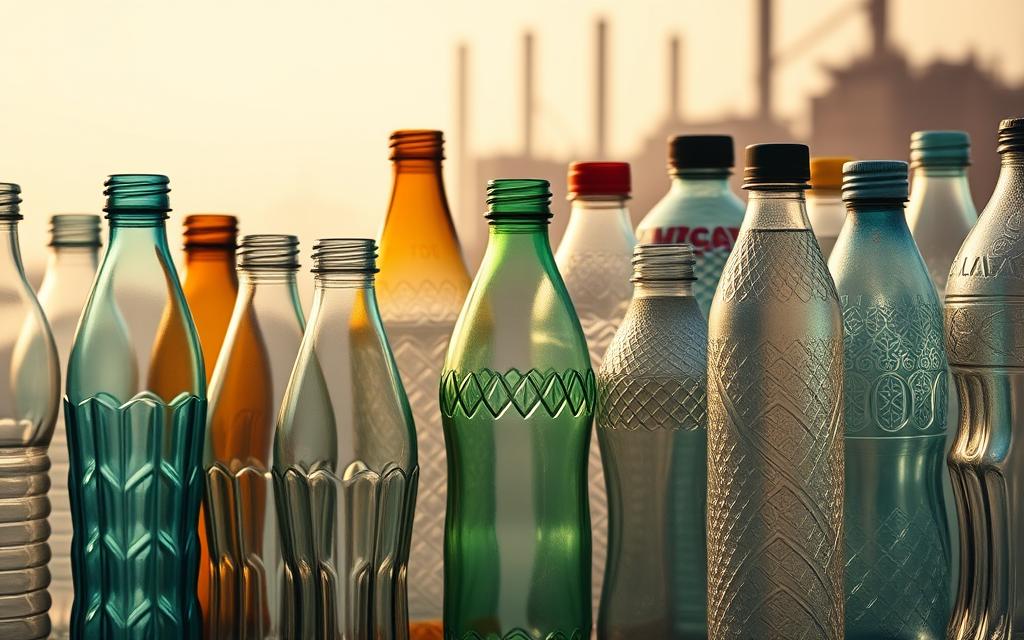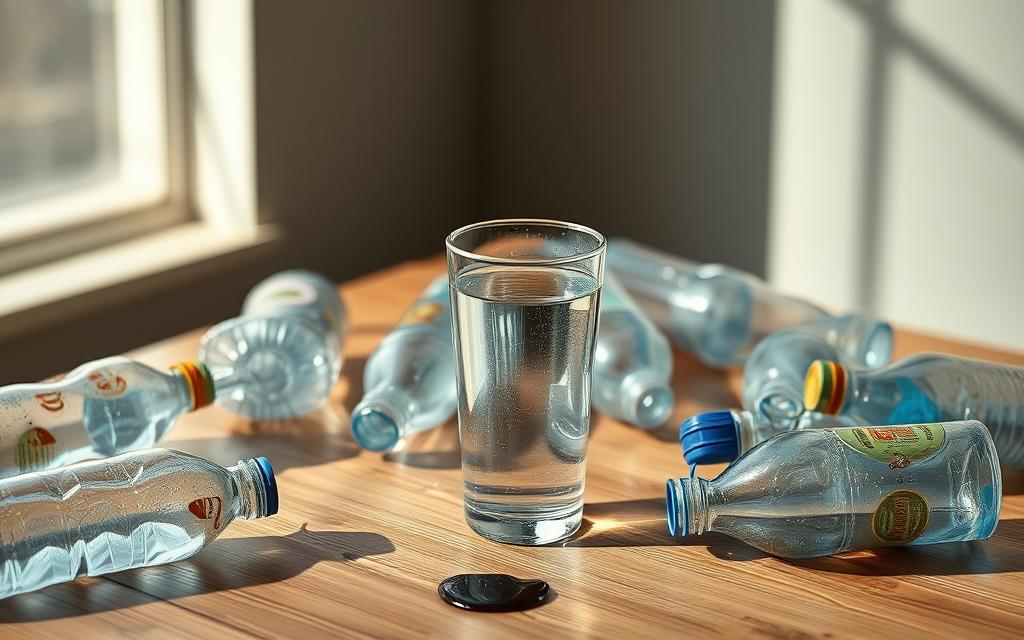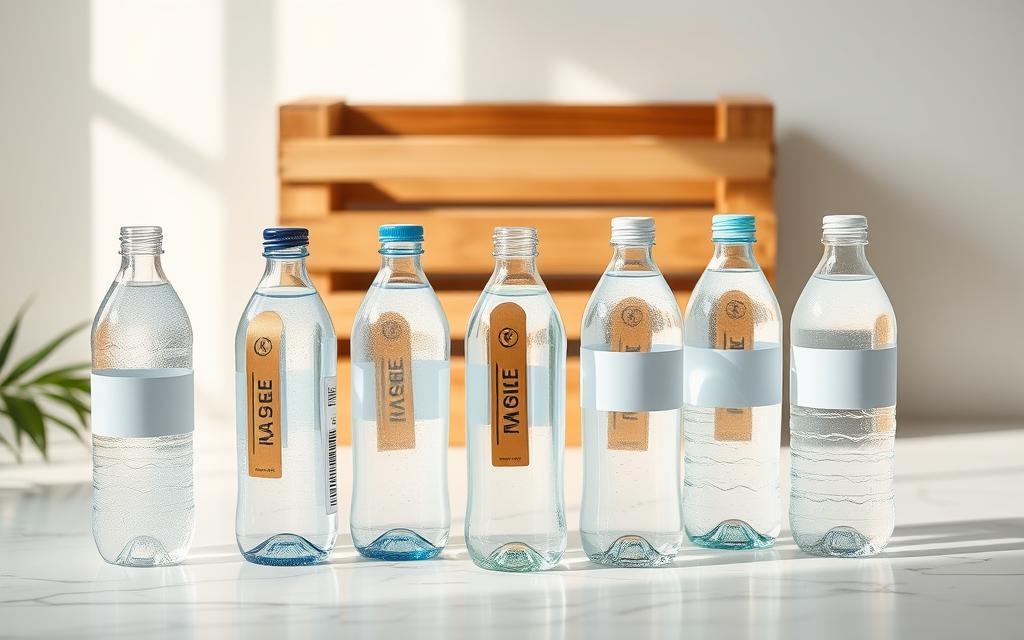Do you know you might be harming your health with every sip from a disposable water bottle? It’s important to ask if drinking from plastic bottles every day is bad for you. Millions of Americans use plastic water bottles daily, and I’ve looked into the risks they might pose.
Health experts are worried about the effects of plastic water bottles. Studies show that these bottles might not be as safe as we think. They could be leaking chemicals or even tiny plastic particles into our water.
I’m here to help you understand the risks of plastic water bottles. We’ll look at the latest research and find safer ways to stay hydrated. This way, you can make better choices for your health and the planet.
Key Takeaways
- Plastic water bottles may contain harmful chemicals that can leach into your drinking water
- Daily use of plastic bottles increases the risk to your health
- Microplastics and chemicals can harm your health over time
- There are safer alternatives to plastic water bottles available
- Knowing the risks helps you make better choices for your health
The Rise of Plastic Water Bottles
Plastic water bottles have become a big deal worldwide, changing how we drink water. At first, we didn’t see the risks of using them every day.

The story of plastic water bottles started in the 1950s. It was a big change in how we carry drinks. These bottles quickly became a common sight in the US.
Origins and Early Development
Plastic water bottles came from new tech in polymers. Important moments in their growth include:
- 1960s: First lightweight plastic bottles introduced
- 1970s: Portable water packaging gains popularity
- 1990s: Mass commercial production begins
Popularity in the United States
As more people used plastic water bottles, health worries grew. Ads and changes in how we live helped make them popular.
| Decade | Annual Consumption (Billions of Bottles) | Growth Rate |
|---|---|---|
| 1990 | 1.5 | Initial Stage |
| 2000 | 8.5 | 467% Increase |
| 2010 | 28.6 | 237% Increase |
Environmental Impact
The harm plastic water bottles cause is huge. Over 80% of plastic bottles are not recycled, harming our planet a lot.
- Massive waste generation
- High carbon footprint
- Ocean pollution
“We are drowning in a sea of plastic that we ourselves have created.” – Environmental Research Foundation
Health Concerns Linked to Plastic Bottles
Plastic water bottles may seem handy, but they’re harmful to our health. The risks of using them every day go beyond just harming the environment. Scientists have found many health dangers linked to these common containers.
Chemicals Lurking in Plastic
Most plastic water bottles have chemicals that can leak into our water. As scientists look into these dangers, concerns about plastic bottle safety grow.
- Microplastics smaller than human cells
- Chemical compounds that disrupt hormonal balance
- Synthetic substances that may accumulate in human tissue
BPA: A Persistent Health Threat
Bisphenol A (BPA) is a big worry in plastic water bottles. Studies show BPA can act like estrogen in our bodies, leading to serious health problems.
| Chemical | Potential Health Impact | Risk Level |
|---|---|---|
| BPA | Hormonal disruption | High |
| Phthalates | Reproductive issues | Medium |
| Nanoplastics | Cellular penetration | Emerging |
Additional Harmful Substances
Nanoplastics are another big worry. These tiny particles can get into our digestive system and blood. They might spread harmful chemicals all over our bodies.
Nanoplastics are so small they can penetrate human cells, raising significant health concerns for long-term plastic bottle users.
Daily Plastic Bottle Usage Statistics
Plastic water bottles are a big problem in the United States. Looking into how often we use them shows us some scary facts. These facts tell us a lot about our drinking habits and health risks.
Recent studies have found some shocking numbers about plastic water bottles. The average American uses about 156 plastic water bottles every year. This has a huge impact on our environment and health.
Average Consumption Rates
- Adults drink around 17 bottles a month
- Teenagers use 12-15 bottles a week
- Children drink 8-10 bottles a week
Demographics of Users
Who uses plastic water bottles the most? It’s mostly urban professionals and college students. They drink the most bottled water.
“One liter of water has about 240,000 plastic particles, with 90% being nanoplastics,” says new research.
Trends Over Time
The market for plastic water bottles has grown a lot. From 2010 to 2020, the use of bottled water went up by almost 65%. This shows a worrying trend of relying on single-use plastics.
By looking at these numbers, we can see how our daily choices affect us and the planet. It’s important to understand these effects for our health and the environment.
Alternatives to Plastic Water Bottles
Wondering if it’s bad to drink out of plastic water bottles every day? The good news is you have plenty of safer alternatives. These can help minimize plastic water bottle health effects. Let’s explore some eco-friendly options that protect both your health and the environment.
Choosing the right water container can make a big difference. It can reduce your exposure to harmful chemicals. I’ve researched several sustainable options that offer both safety and convenience.
Stainless Steel Bottles: The Durable Champion
Stainless steel bottles are a top alternative to plastic. They offer many benefits:
- Zero chemical leaching
- Extremely durable
- Keeps beverages hot or cold for hours
- Easy to clean and maintain
Glass Water Bottles: Pure and Clean
For those seeking ultimate purity, glass water bottles are an excellent choice. They eliminate concerns about plastic water bottle health effects by providing:
- 100% non-toxic material
- No chemical transfer
- Transparent and easy to monitor cleanliness
Eco-Friendly Plastic Options
If you’re not ready to completely abandon plastic, consider modern alternatives. Look for bottles labeled:
- BPA-free
- Made from recycled materials
- Designed for multiple uses
By making informed choices about your water containers, you can significantly reduce risks. Your health and the planet will thank you!
Simple Tips for Safer Drinking
Dealing with the risks of plastic water bottles can be tough. I’ll guide you on how to pick better drinking water options. This way, you can lower health risks from plastic bottles.
Knowing how to handle your water bottles is key to staying healthy. Here are some easy tips to make drinking safer and better for you.
Choosing BPA-Free Options
When picking water bottles, look for these important features:
- Bottles labeled BPA-free
- Plastic types #2 (HDPE), #4 (LDPE), and #5 (PP)
- Transparent materials without chemical odors
Proper Cleaning Techniques
Cleaning your bottles right stops bacteria growth and keeps them clean:
- Wash with warm, soapy water after each use
- Use a bottle brush to reach hard spots
- Air dry completely before storing
- Replace bottles when they show wear or scratches
Storage Recommendations
Storing your bottles smartly can help avoid risks:
- Keep bottles away from direct sunlight
- Store in cool, dry places
- Avoid extreme temperatures
- Replace bottles every 6-12 months
Some myths say heating, freezing, and reusing bottles are bad. But science shows these actions don’t release harmful chemicals.
Environmental Effects of Plastic Waste
Using plastic water bottles daily harms more than just our health. It’s a big problem for our planet, hurting marine life and land.
Plastic water bottles are not just a personal issue. They have a huge impact on our environment. This damage affects our natural world in many ways.
Impact on Marine Life
Marine life is suffering from plastic pollution. Thousands of sea creatures die each year, thinking plastic is food. They get hurt or killed by getting tangled in plastic bottles.
- Approximately 8 million metric tons of plastic enter oceans annually
- Microplastics contaminate marine food chains
- Plastic debris kills over 100,000 marine mammals yearly
Contribution to Landfills
Plastic water bottles are a big problem for waste management. In the United States, nearly 50 billion plastic bottles are bought every year. Most of them end up in landfills or the environment.
Community Clean-Up Efforts
Local communities are taking action against plastic waste. They organize beach cleanups, start recycling programs, and teach about the issue. These efforts help lessen the damage.
- Volunteer beach cleaning events
- School recycling education programs
- Local government plastic reduction strategies
“Every plastic bottle not used is a step toward environmental protection.” – Environmental Conservation Network
Government Regulations and Guidelines
The world of plastic water bottle rules is complex. It deals with safety and the environment. Governments around the world are looking into the dangers of daily plastic water bottle use.
The United States Food and Drug Administration (FDA) is key in checking plastic water bottle safety. They set strict rules to keep people safe from plastic dangers.
FDA Safety Standards
My research shows the FDA has several important rules:
- They test for chemicals that can leak into drinks.
- They limit harmful substances in plastic.
- They watch over the materials used in plastic bottles.
Local and State Regulations
States are making their own rules for plastic bottles:
| State | Key Regulation | Implementation Year |
|---|---|---|
| California | Plastic Bottle Reduction Act | 2021 |
| New York | Single-Use Plastic Restrictions | 2020 |
| Hawaii | Comprehensive Plastic Ban | 2022 |
Global Perspectives
Across the globe, countries have different ways to handle plastic water bottle rules. The European Union has been very strict, with rules that are much tougher than in the U.S.
Rules are changing as we learn more about plastic bottle effects.
Even with progress, there are big challenges. Creating global rules that cover all risks is hard.
Long-Term Health Implications
Drinking from plastic water bottles daily might seem okay, but science shows there are risks. These risks can affect our bodies in small but big ways over time.
Studies have found dangers in using plastic bottles every day. The chemicals in plastics can harm our health, more so with long-term use.
Chronic Exposure Risks
Drinking from plastic bottles can expose us to harmful chemicals. These chemicals can build up in our bodies over time. Key concerns include:
- Potential hormone disruption
- Increased risk of cellular damage
- Possible links to metabolic disorders
- Potential impact on reproductive health
Vulnerable Populations
Certain groups face higher risks from plastic water bottle health effects:
- Pregnant women
- Young children
- Individuals with compromised immune systems
- Elderly populations
“The chemicals we consume today may impact our health for years to come” – Environmental Health Research Institute
Research and Studies
Scientific studies have shown scary results. In pregnant mice, researchers found plastic chemicals in the babies’ brains and organs within 24 hours.
Though more research is needed, these early findings highlight the need to understand our plastic use. They encourage us to make better choices about our water.
The Future of Plastic Water Bottles
The world of plastic water bottles is changing fast. People are learning more about the dangers of plastic bottles. New ideas are coming up to make bottles safer and better for the planet.
New technologies are changing how we think about staying hydrated and being green. Scientists and companies are working on new ways to make bottles safer and less harmful to the environment.
Innovations in Bottle Design
- Advanced filtration systems integrated directly into bottle materials
- Smart sensors tracking water quality and chemical composition
- Self-cleaning bottle technologies using UV light
Biodegradable Solutions
New, eco-friendly options are becoming popular. Companies are making bottles that can easily break down. This helps reduce harm to the environment over time.
| Material Type | Decomposition Time | Environmental Impact |
|---|---|---|
| Traditional Plastic | 450-1000 years | Extremely High |
| Plant-Based Plastics | 3-6 months | Low |
| Algae-Derived Bottles | 45-60 days | Minimal |
Company Initiatives for Sustainability
Big companies are putting a lot of money into making bottles better for the planet. They’re focusing on plastic neutrality and circular economy ideas. This is becoming a key part of how they do business.
These new ideas give us hope. They help lower the risks of plastic bottles and make drinking water healthier for us and the planet.
The Debate: Convenience vs. Health
Plastic water bottles are everywhere today, but they raise big questions about health and the environment. Their convenience hides some serious risks.
The Convenience Factor
- Lightweight and portable
- Readily available everywhere
- Quick hydration on the go
- Cheap and accessible
Hidden Health Risks
There’s more to plastic water bottles than meets the eye. The chemicals in them can get into your water, posing health risks.
| Chemical Concern | Potential Health Impact |
|---|---|
| BPA | Hormone disruption |
| Phthalates | Reproductive system damage |
| Antimony | Potential carcinogenic effects |
Finding a Balanced Approach
To stay safe, find a balance. Think about getting a good reusable water bottle made from safe stuff like stainless steel or glass. These options cut down on chemical exposure a lot.
- Choose BPA-free containers
- Avoid leaving bottles in hot environments
- Replace bottles regularly
- Filter your own water when possible
Knowing the risks of plastic water bottles helps you make better choices. Your health is more important than quick convenience.
Personal Choices and Impact
Thinking about the risks of drinking from plastic water bottles every day makes me see how we can make a difference. Our daily choices affect not just our health but also the environment and our community. By choosing wisely, we can cut down on plastic and protect ourselves and the planet.
Knowing the health risks pushes me to find better options. I’ve started using a reusable stainless steel water bottle and filtering tap water. These simple steps help me use less plastic. They also encourage others to think about their plastic use.
Making Informed Decisions
I now think more about what I buy. I choose glass or stainless steel over plastic, support eco-friendly brands, and learn about plastic health risks. This way, I make choices that are good for me and the planet.
Engaging in Community Efforts
Getting involved in my community has made a big difference. I’ve joined beach cleanups and supported local plastic reduction efforts. Every small action helps and raises awareness about the need to reduce plastic waste.
Encouraging Sustainable Practices
I’ve learned that living sustainably is a team effort. By sharing what I know, supporting green businesses, and making smart choices, I can motivate others. Starting to reduce plastic use begins with personal commitment and grows with community support.



